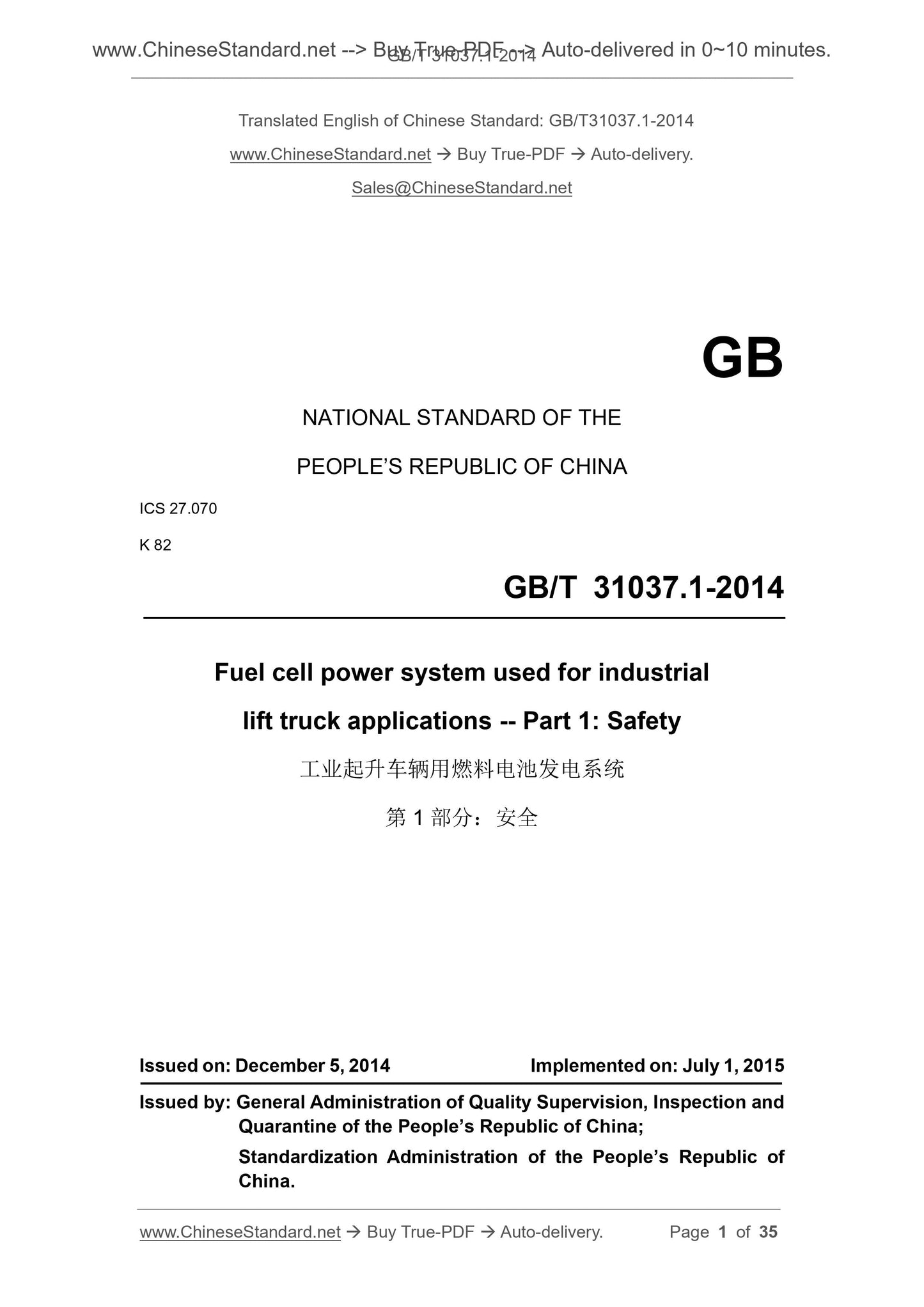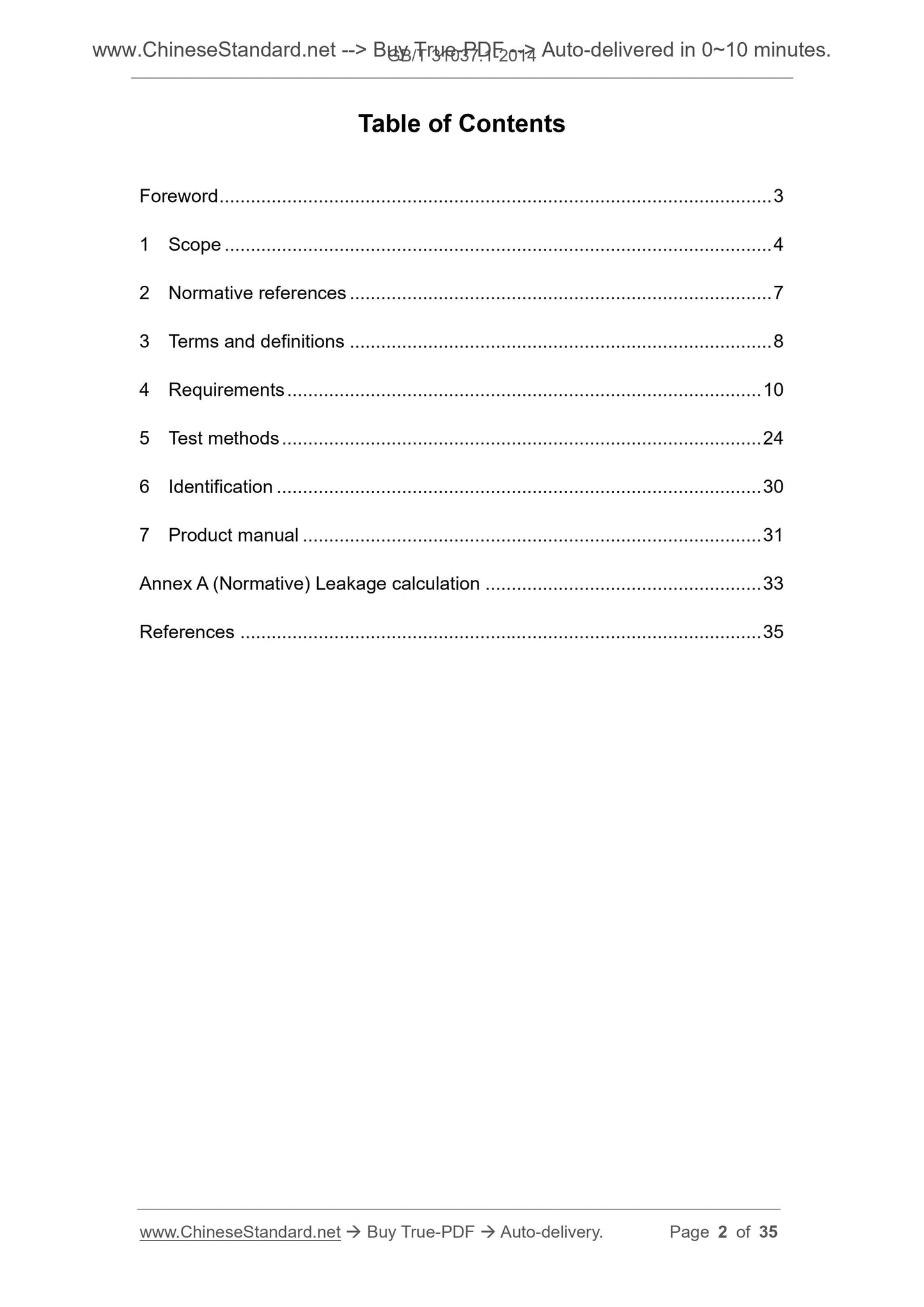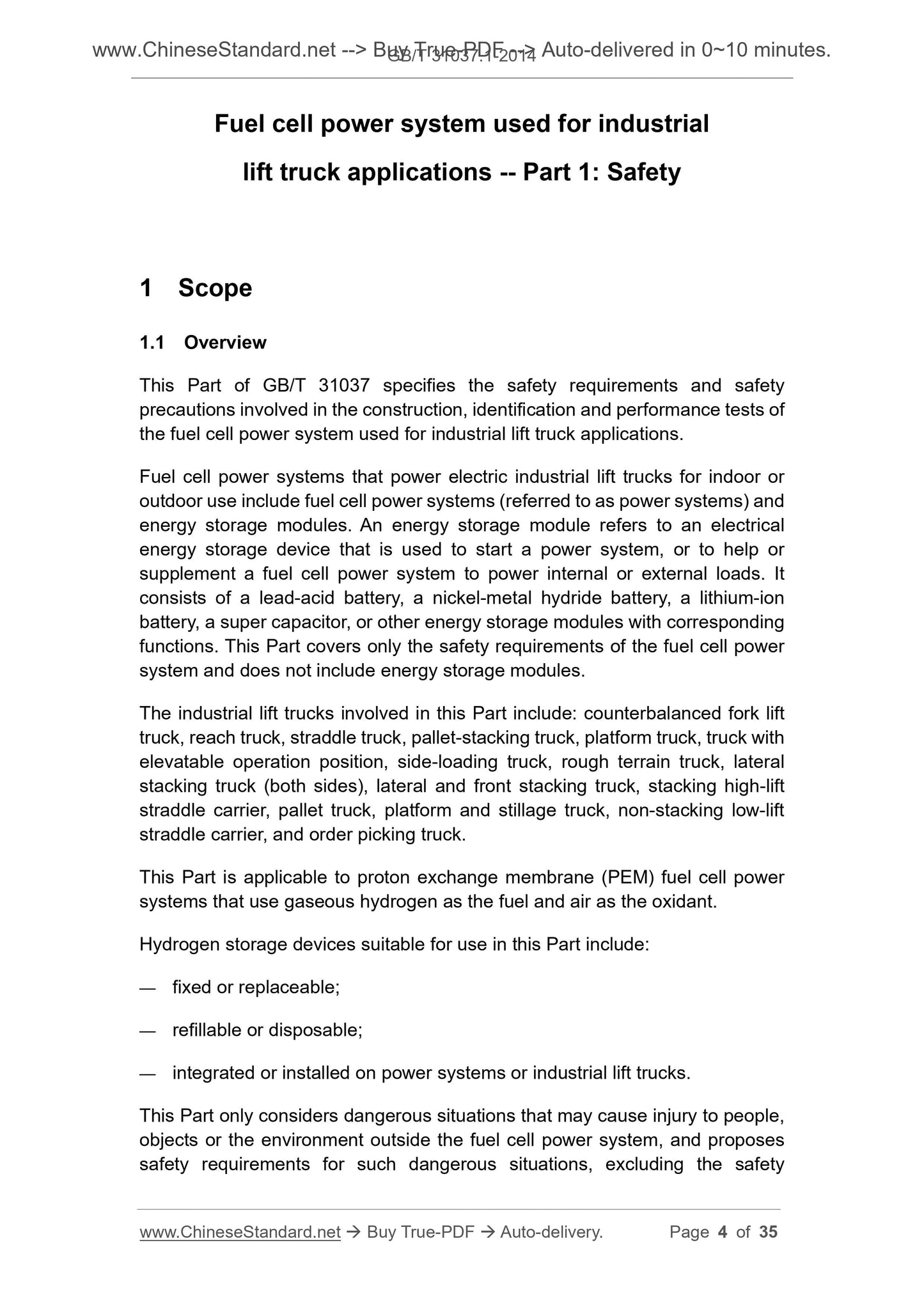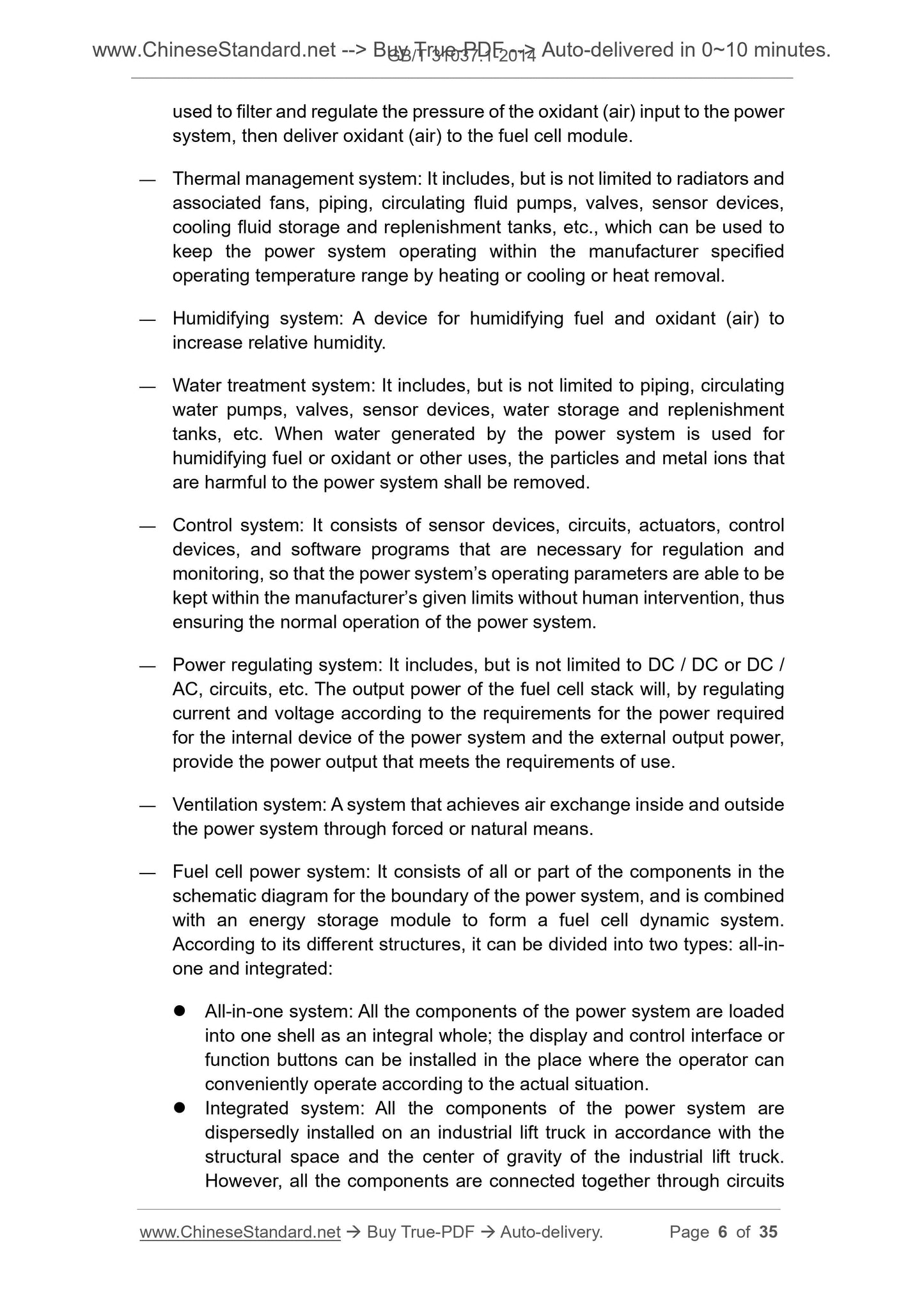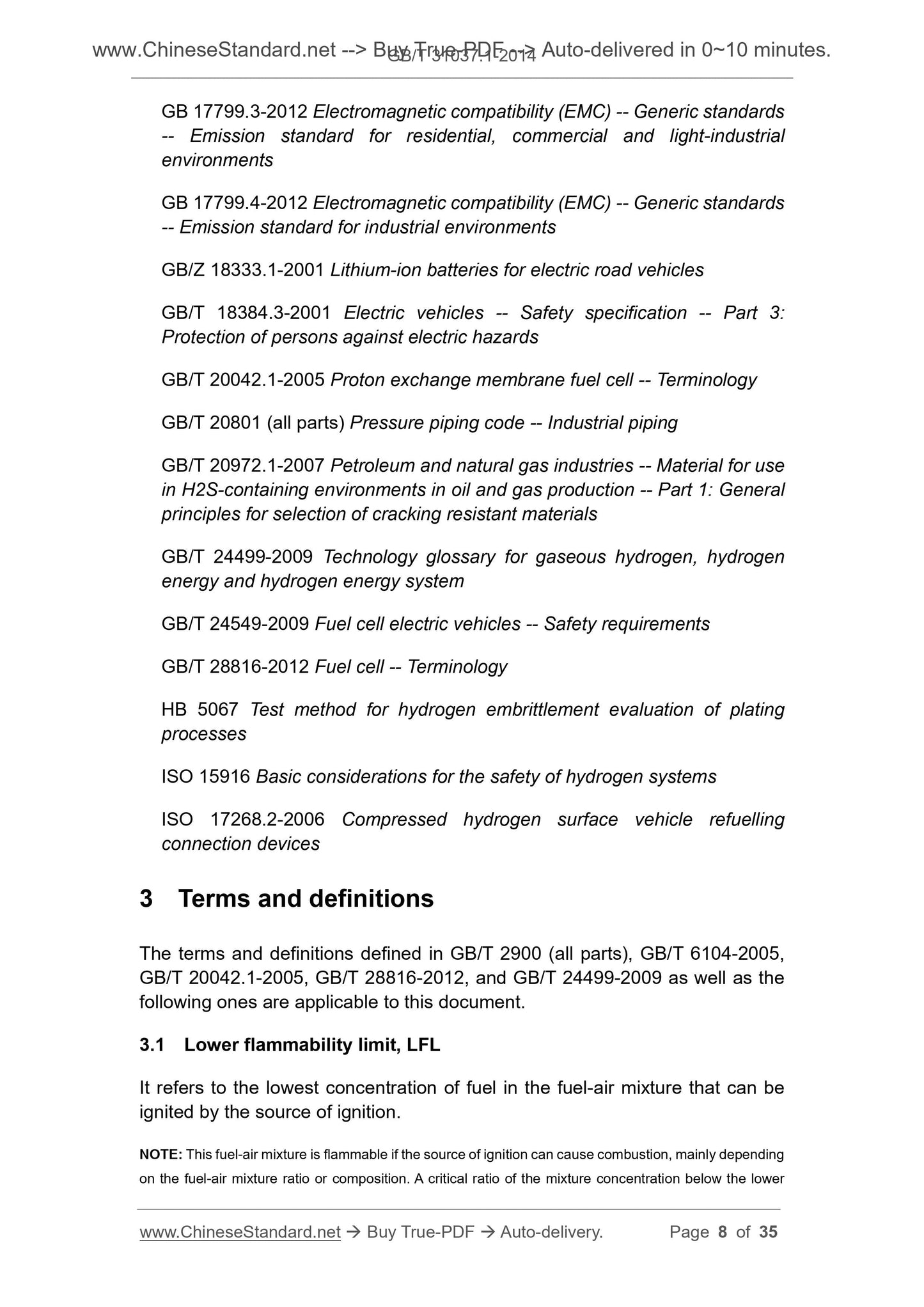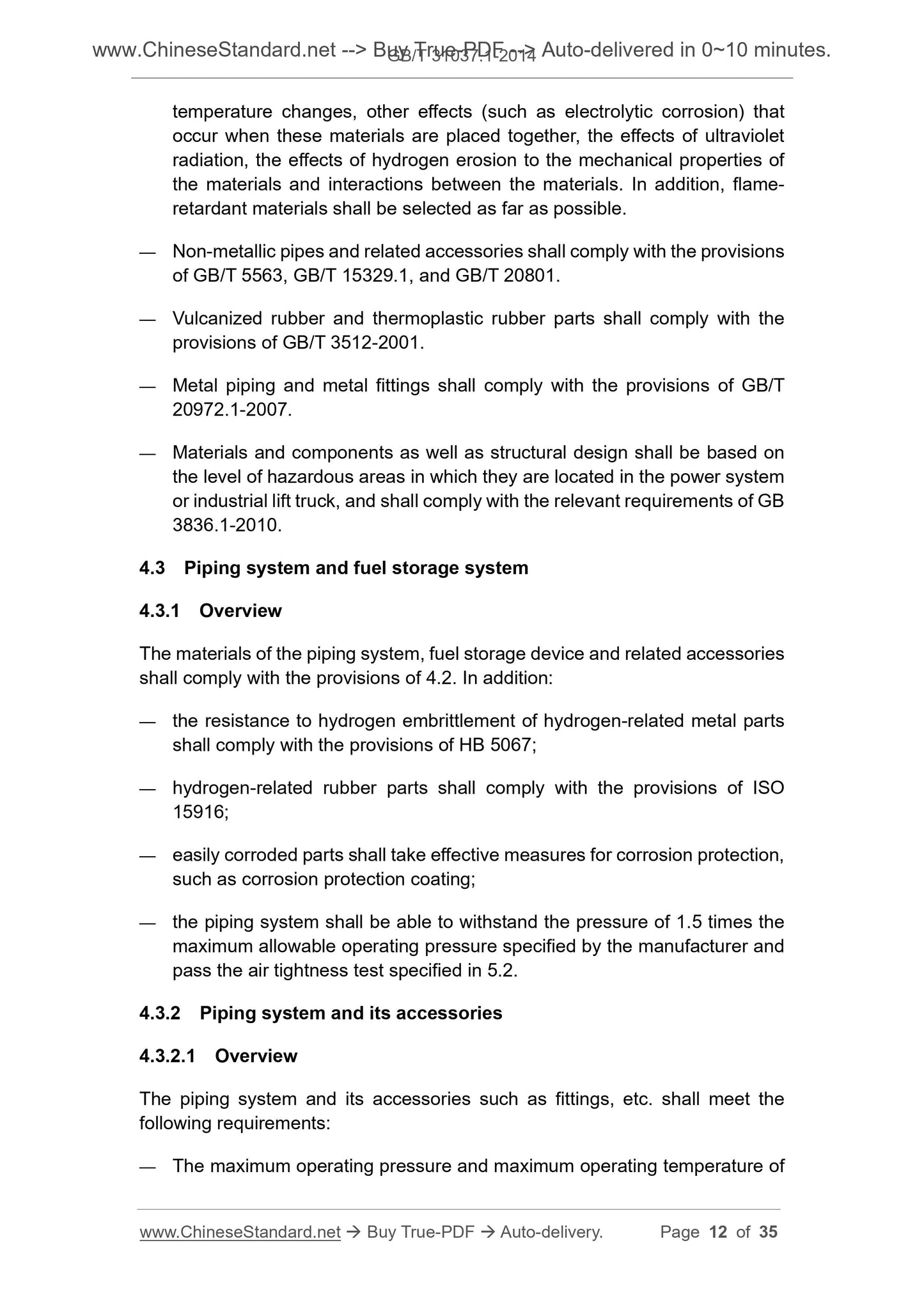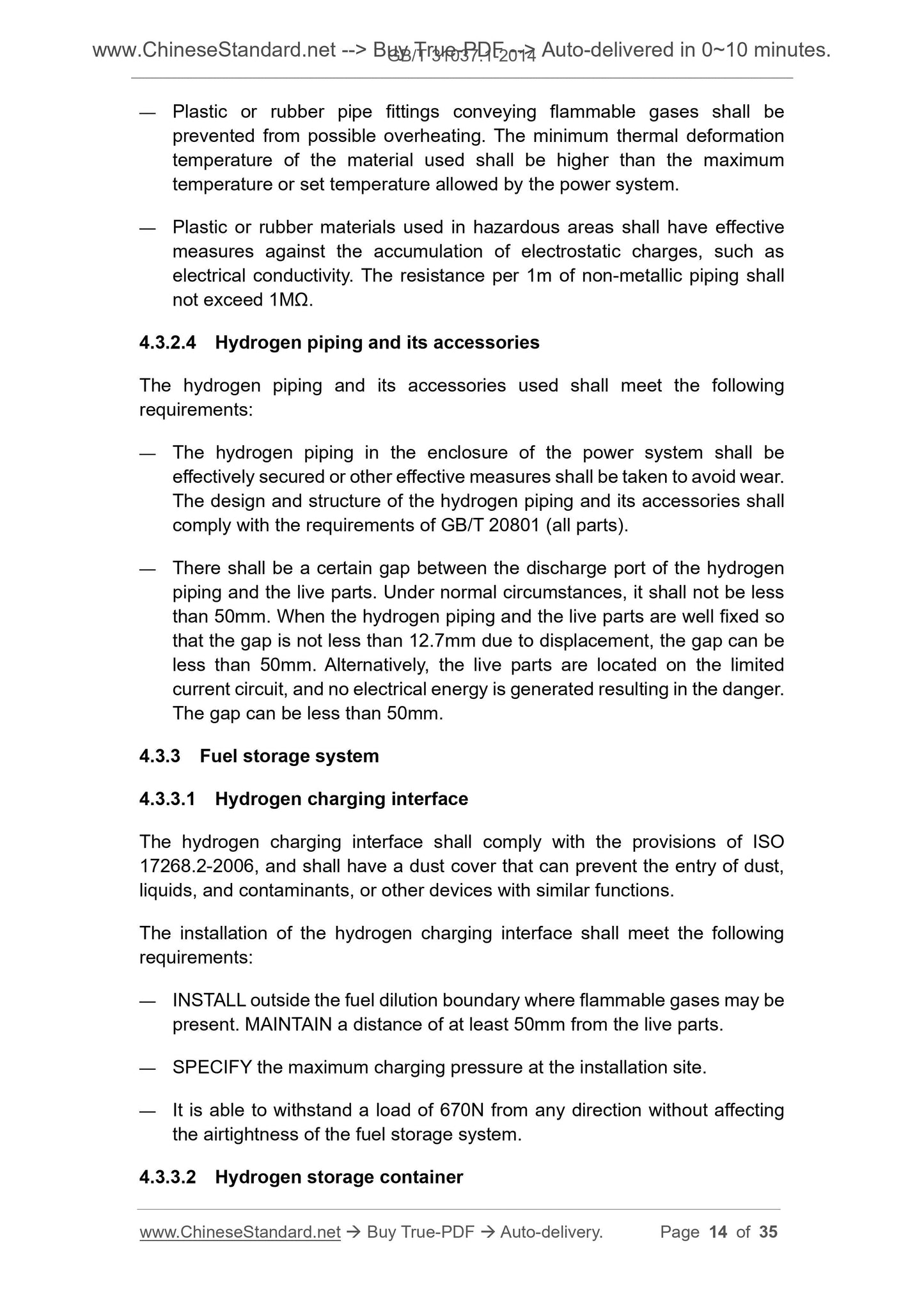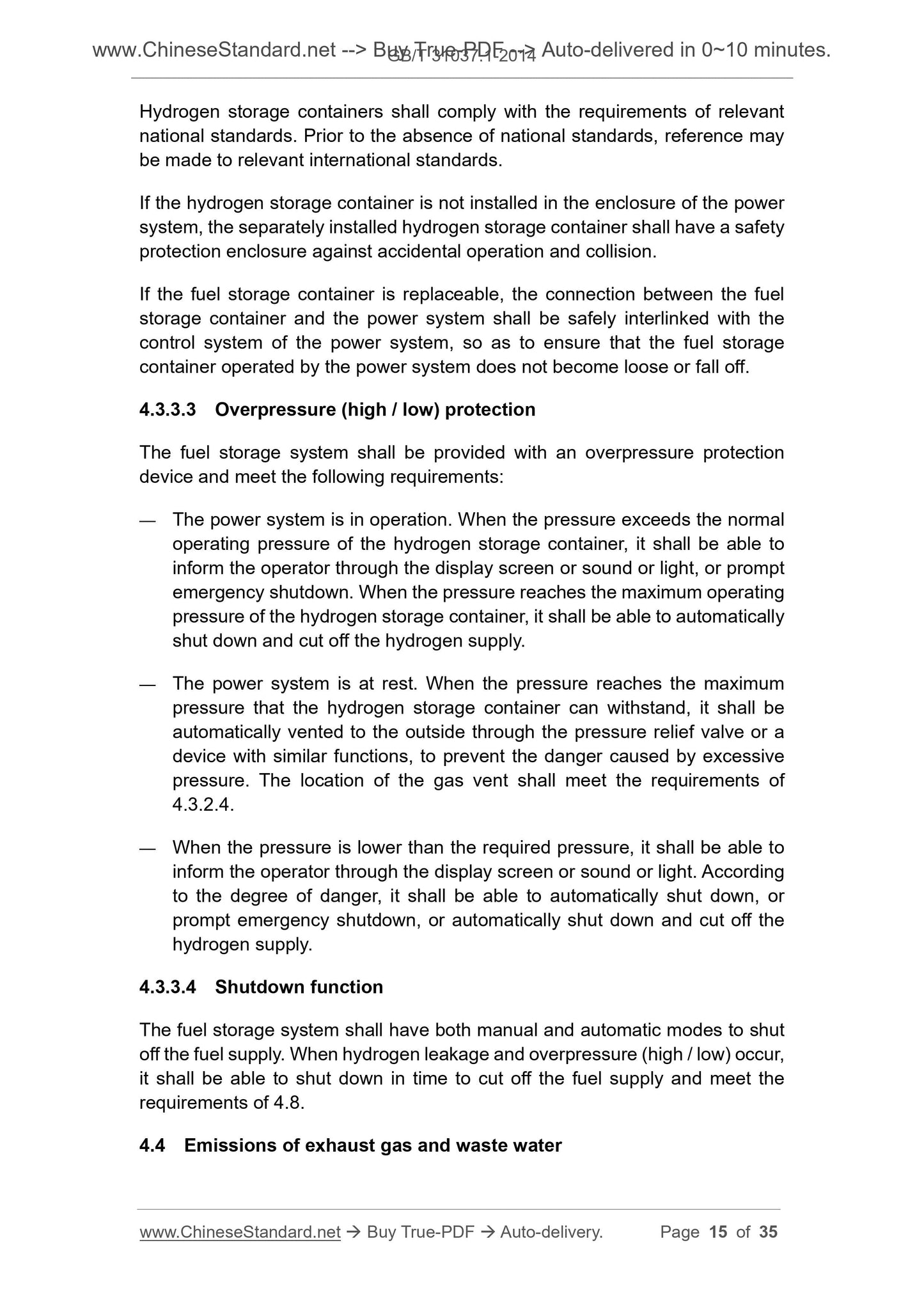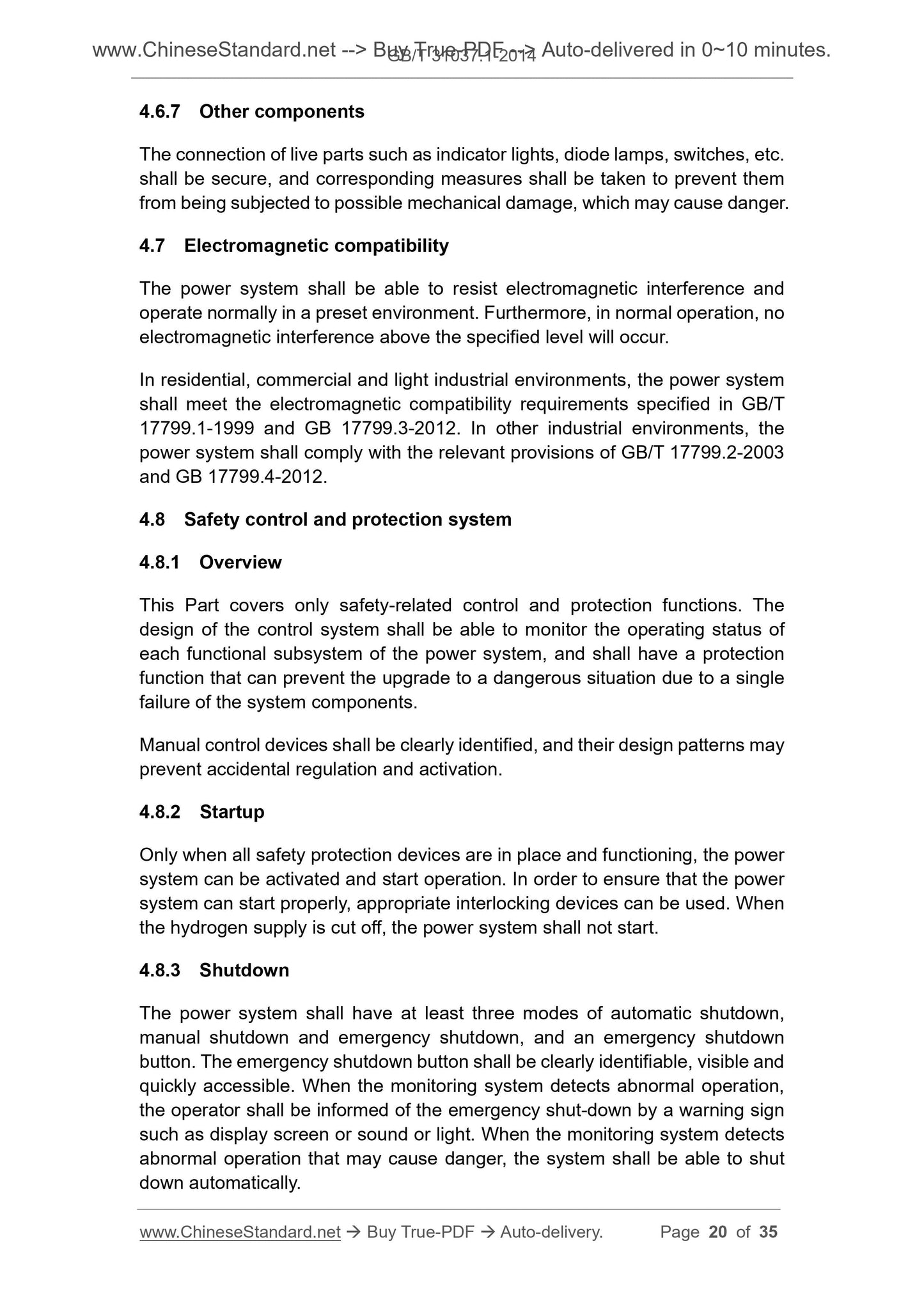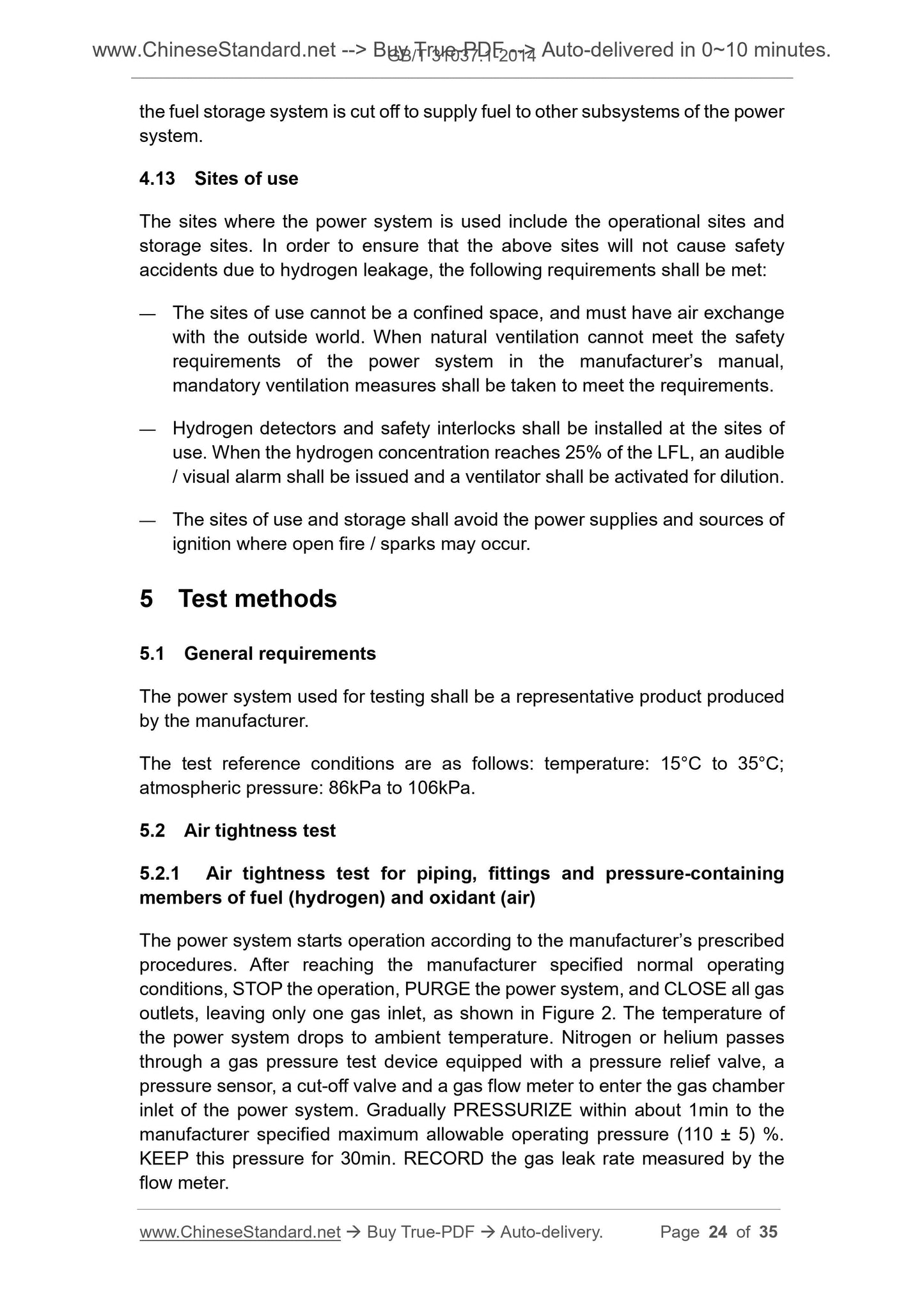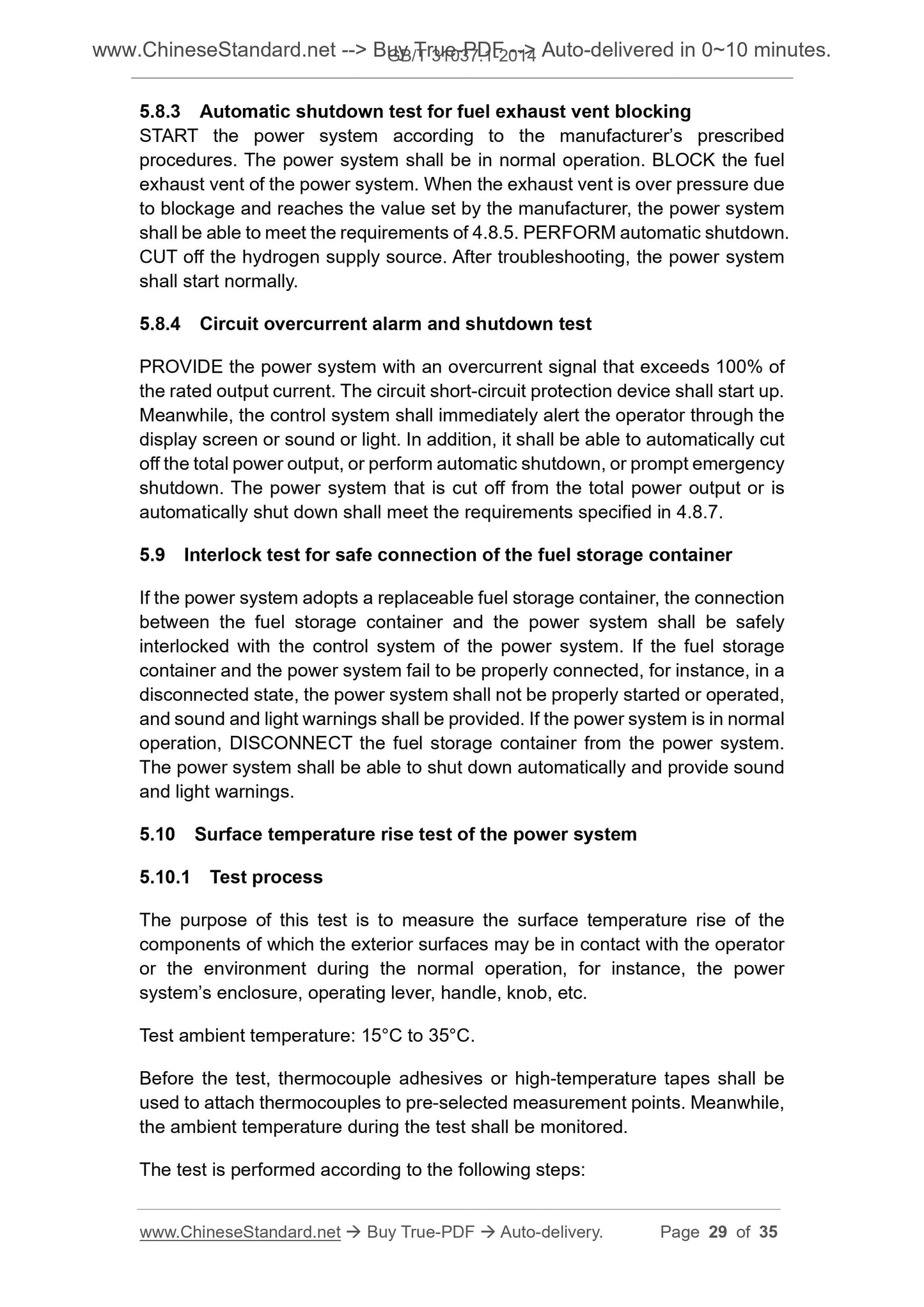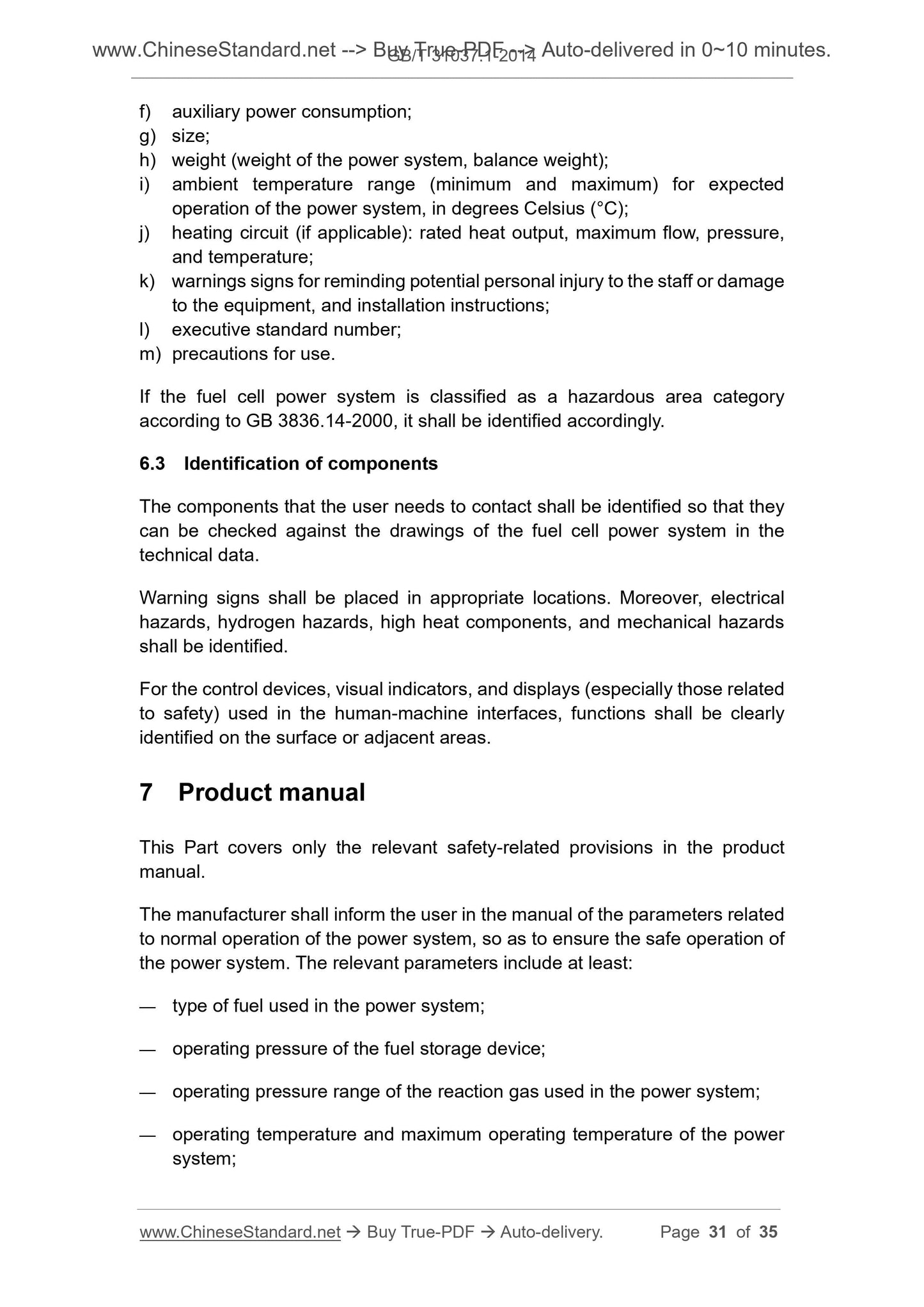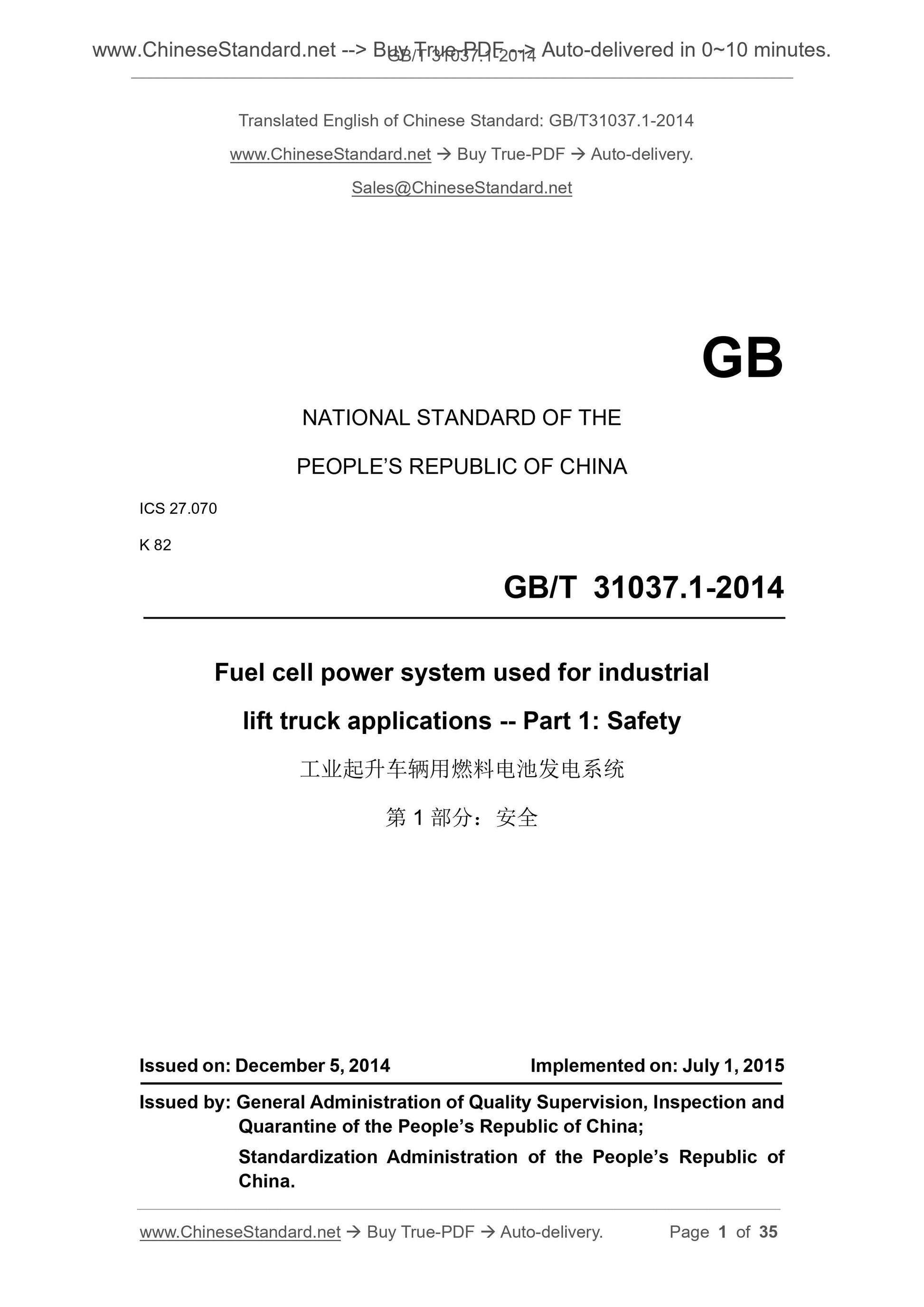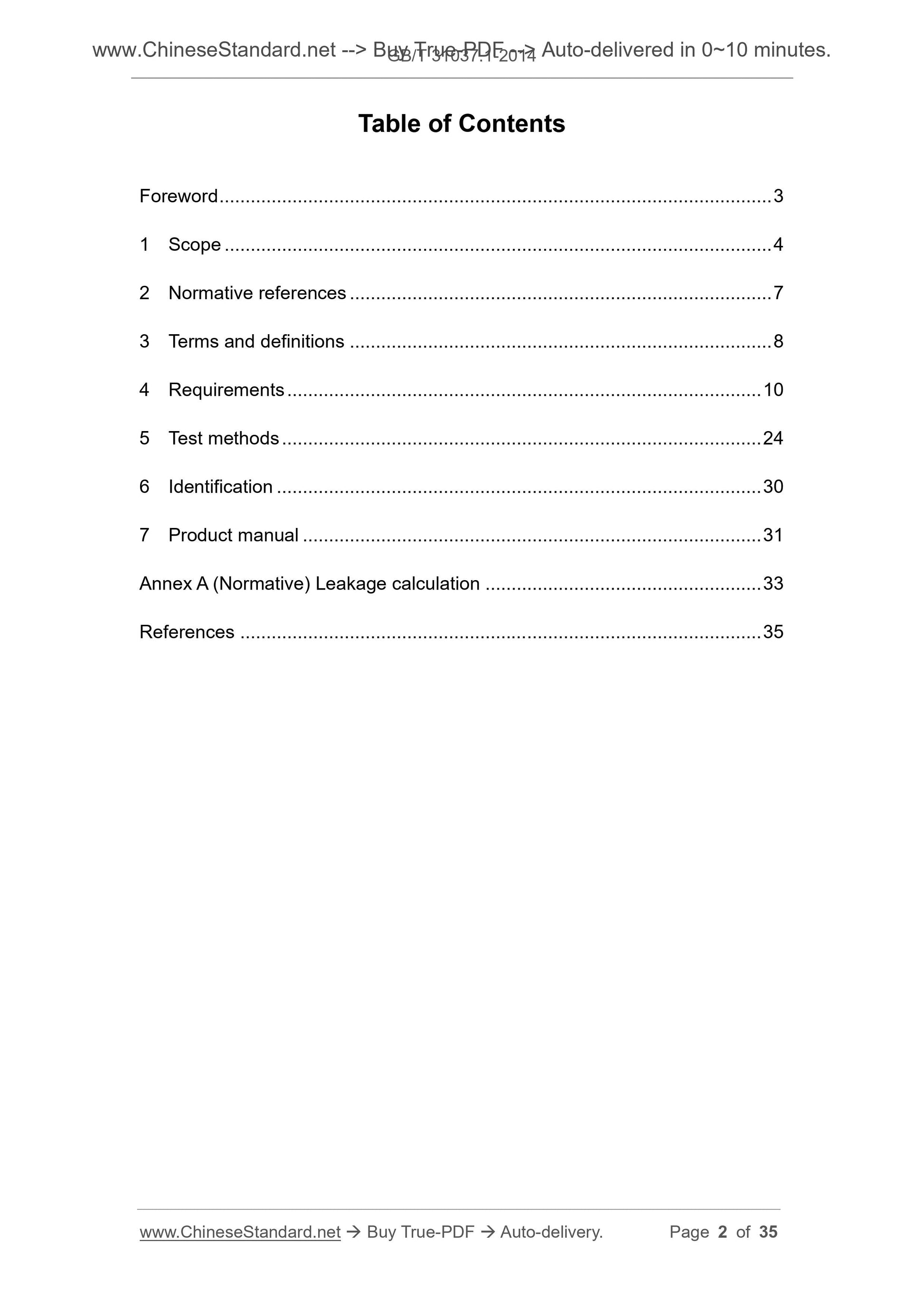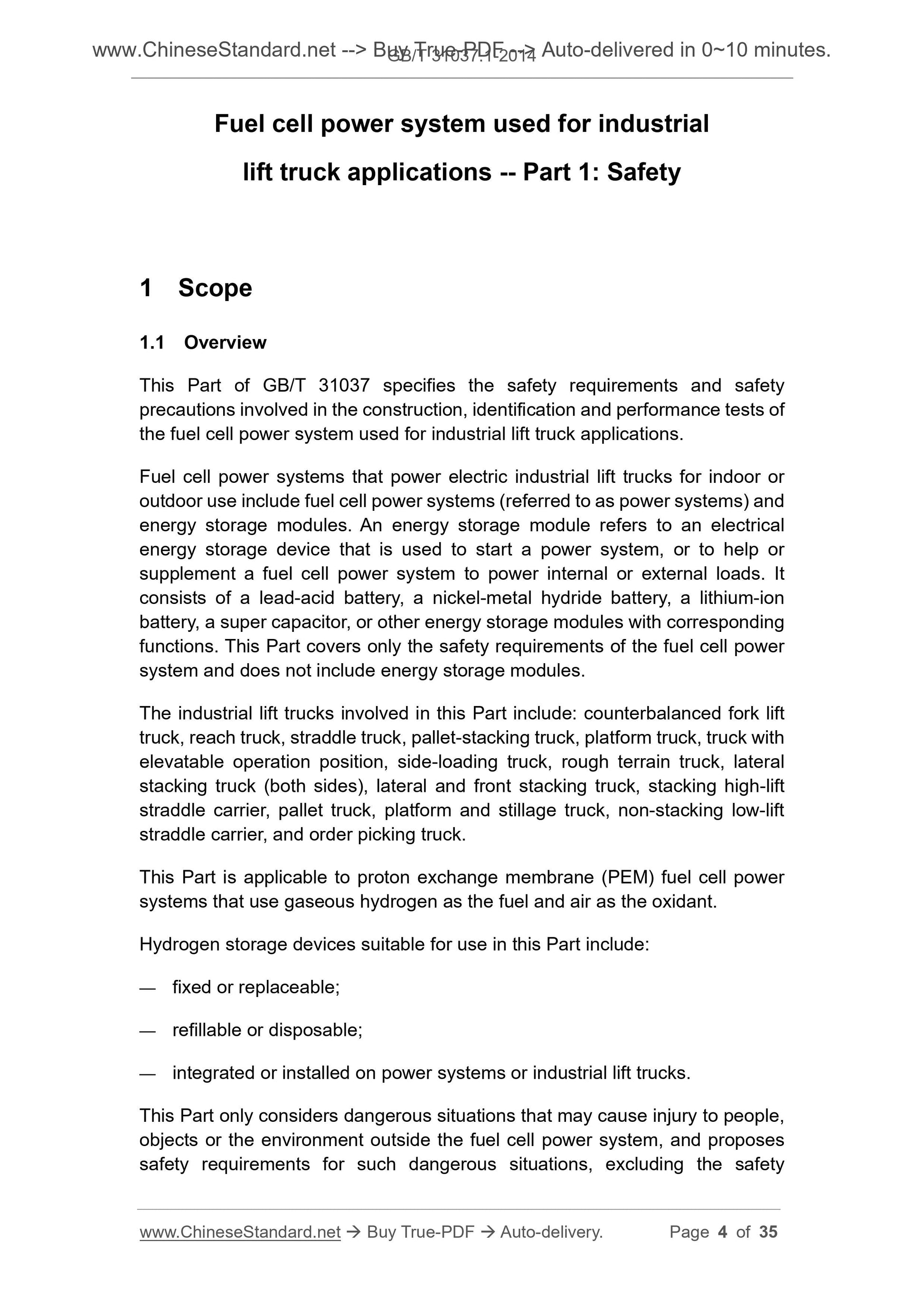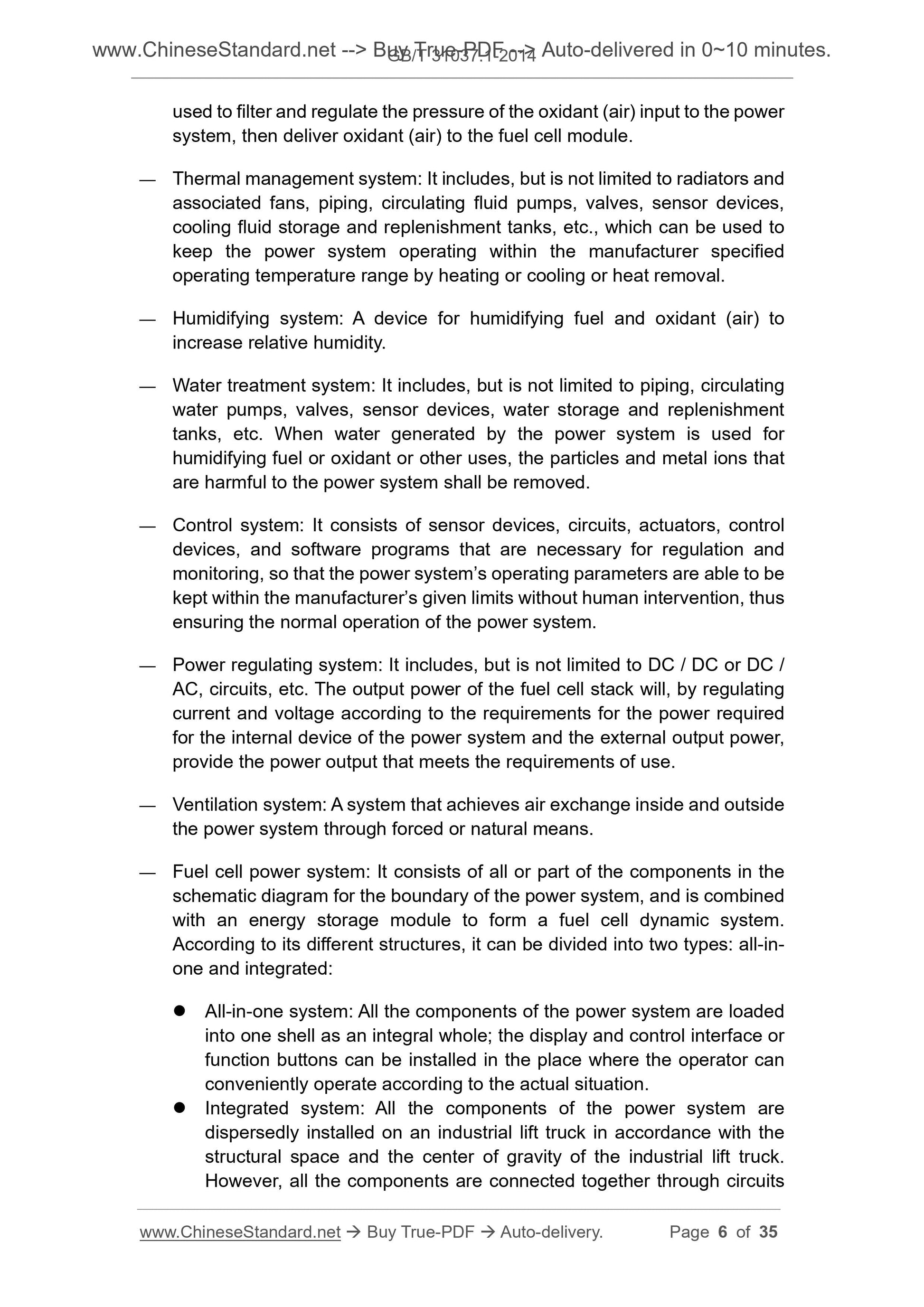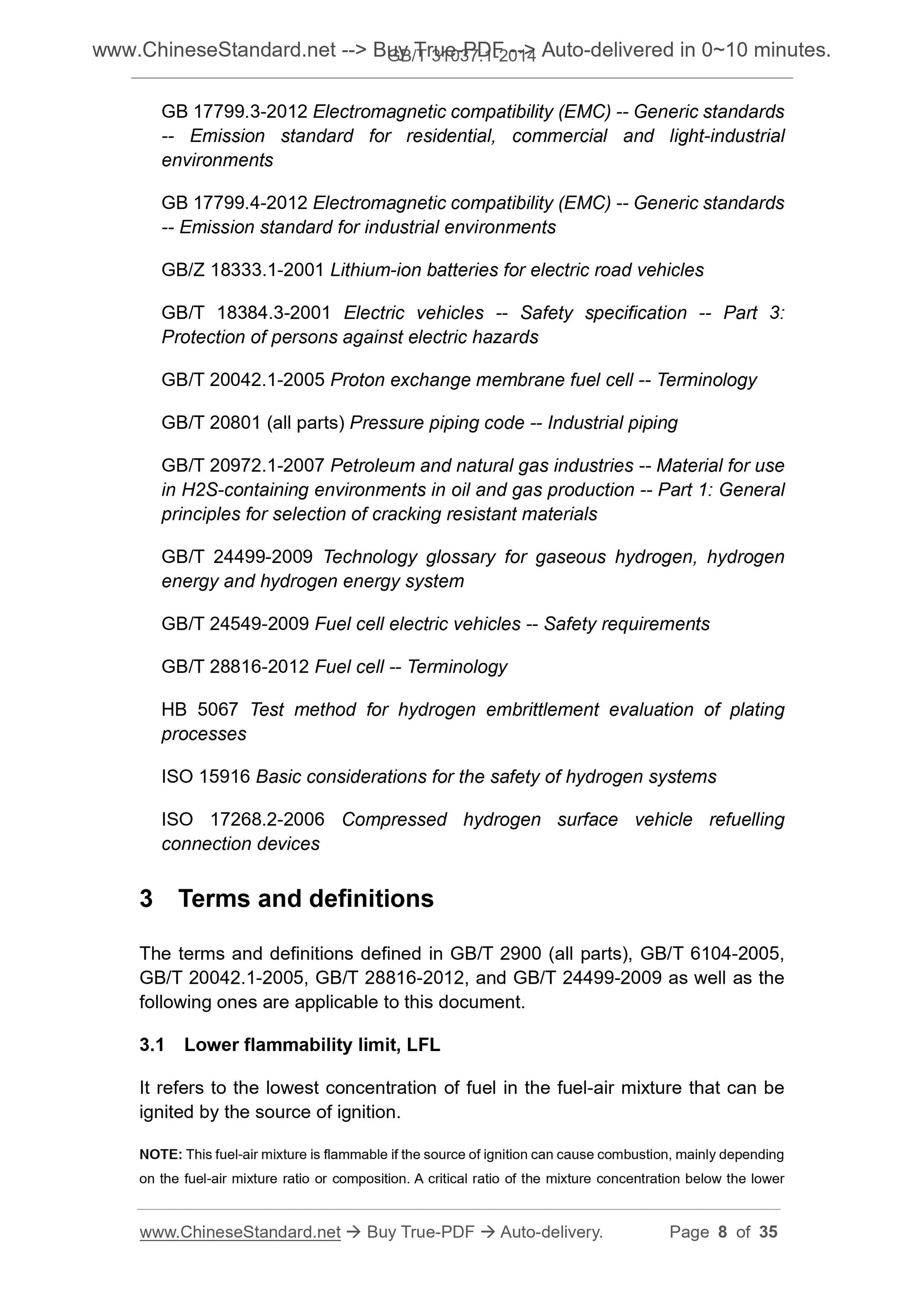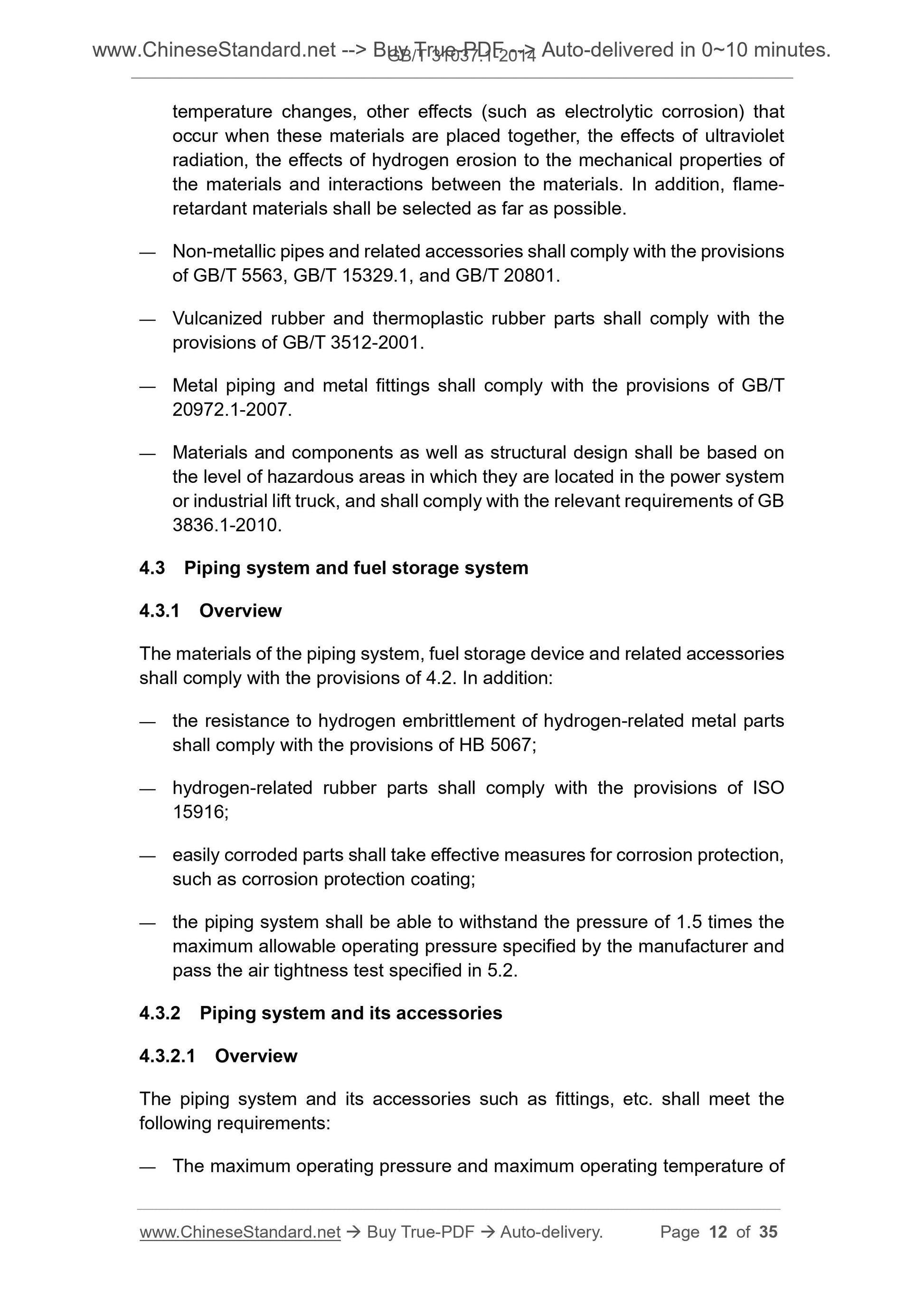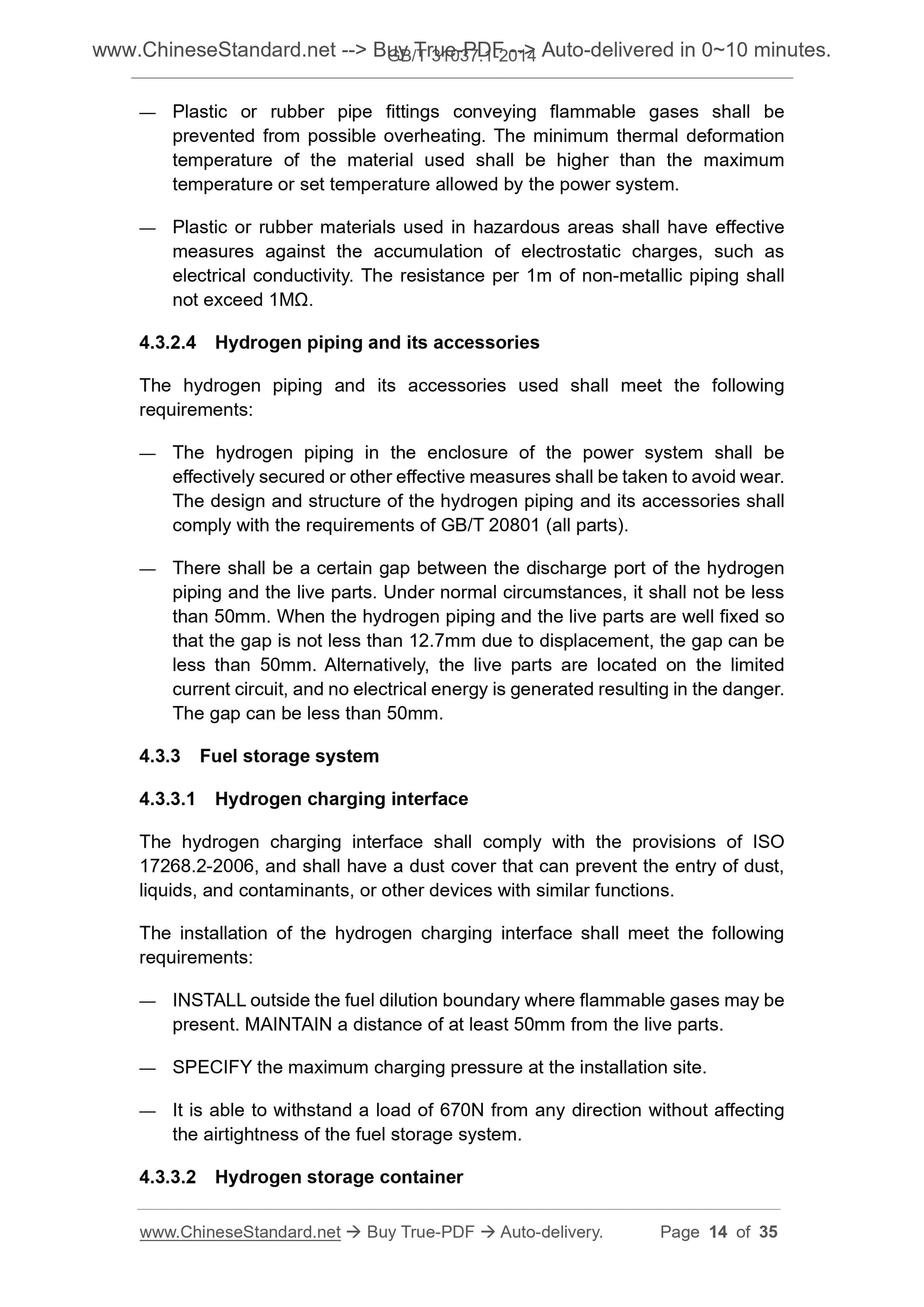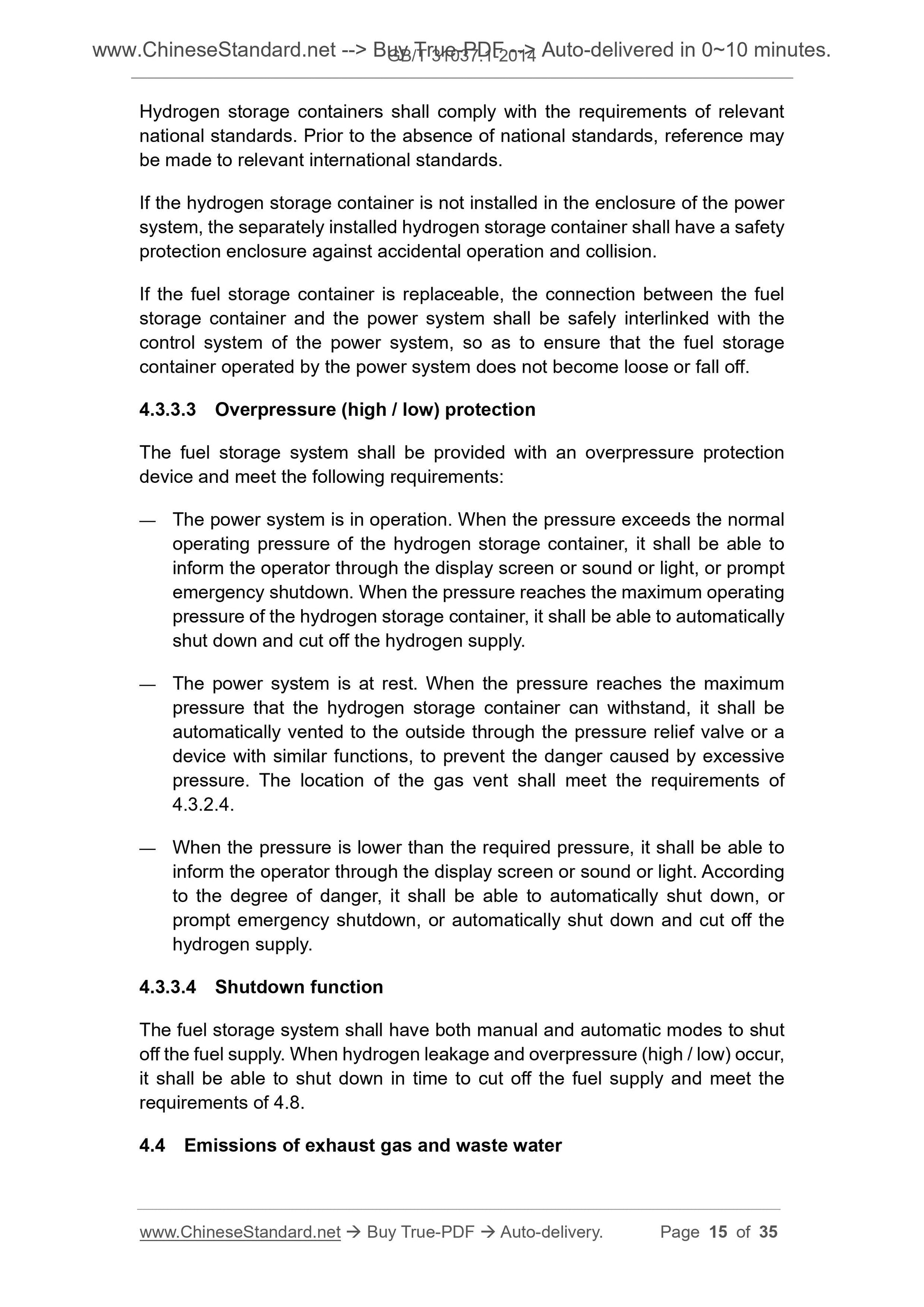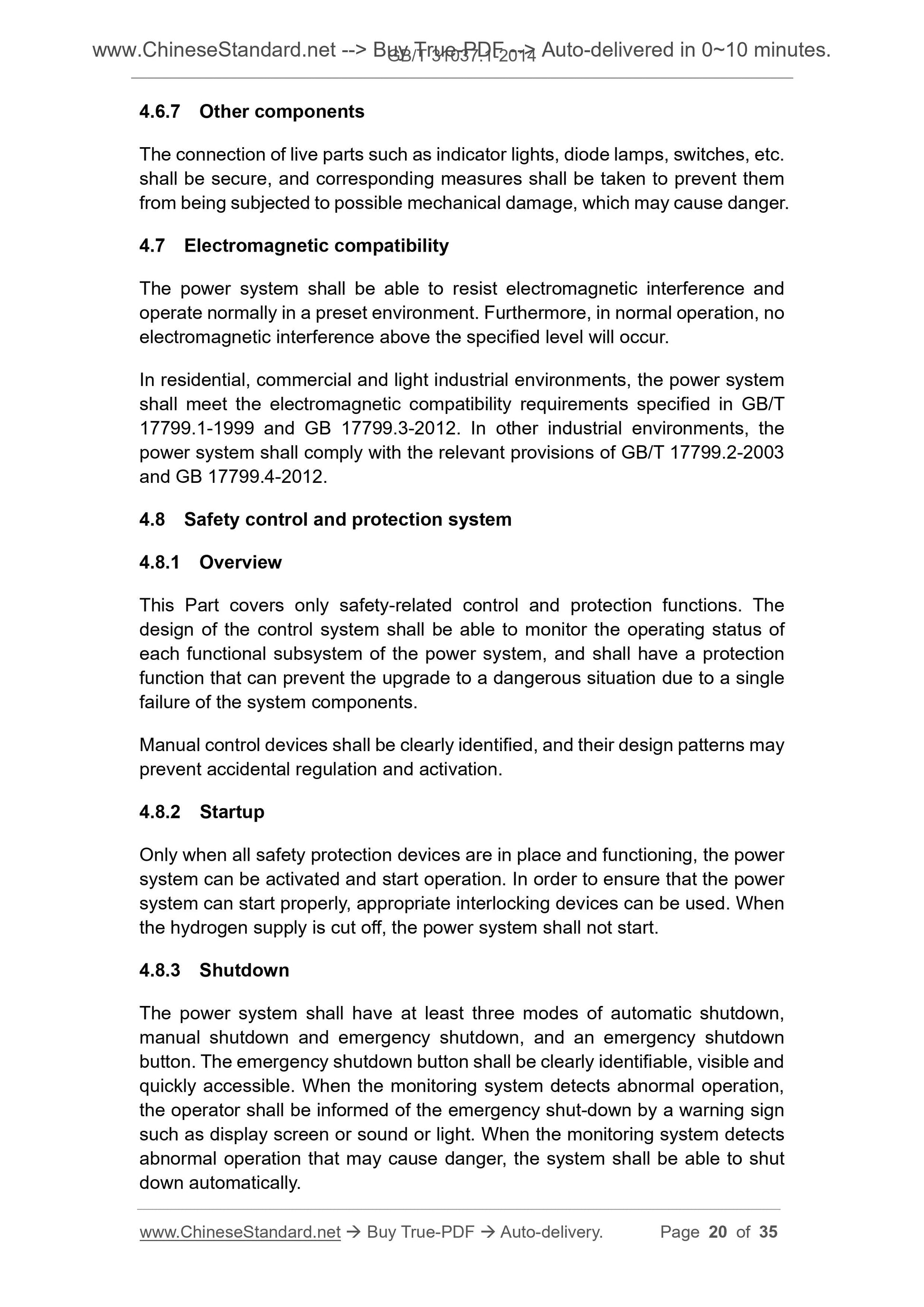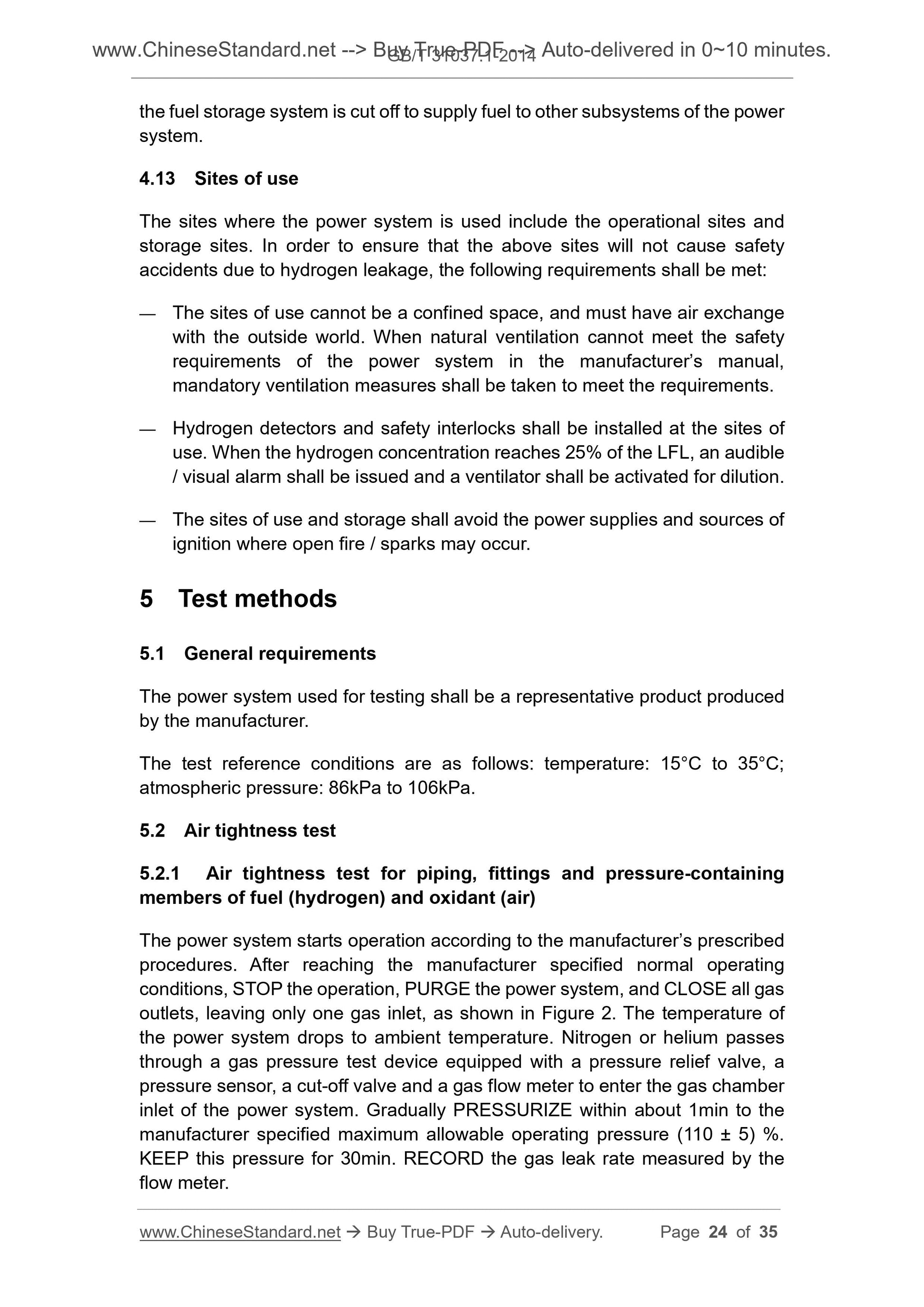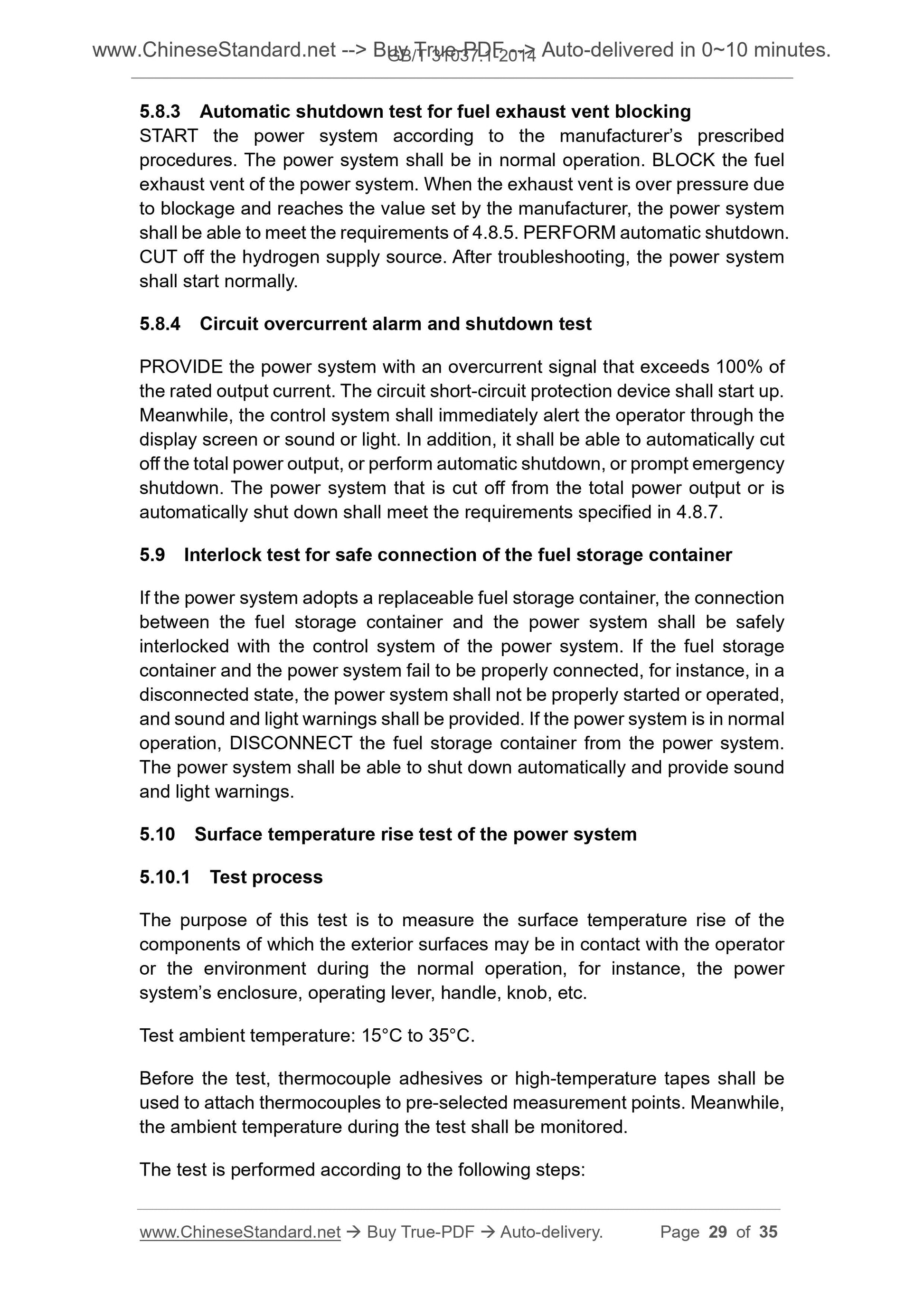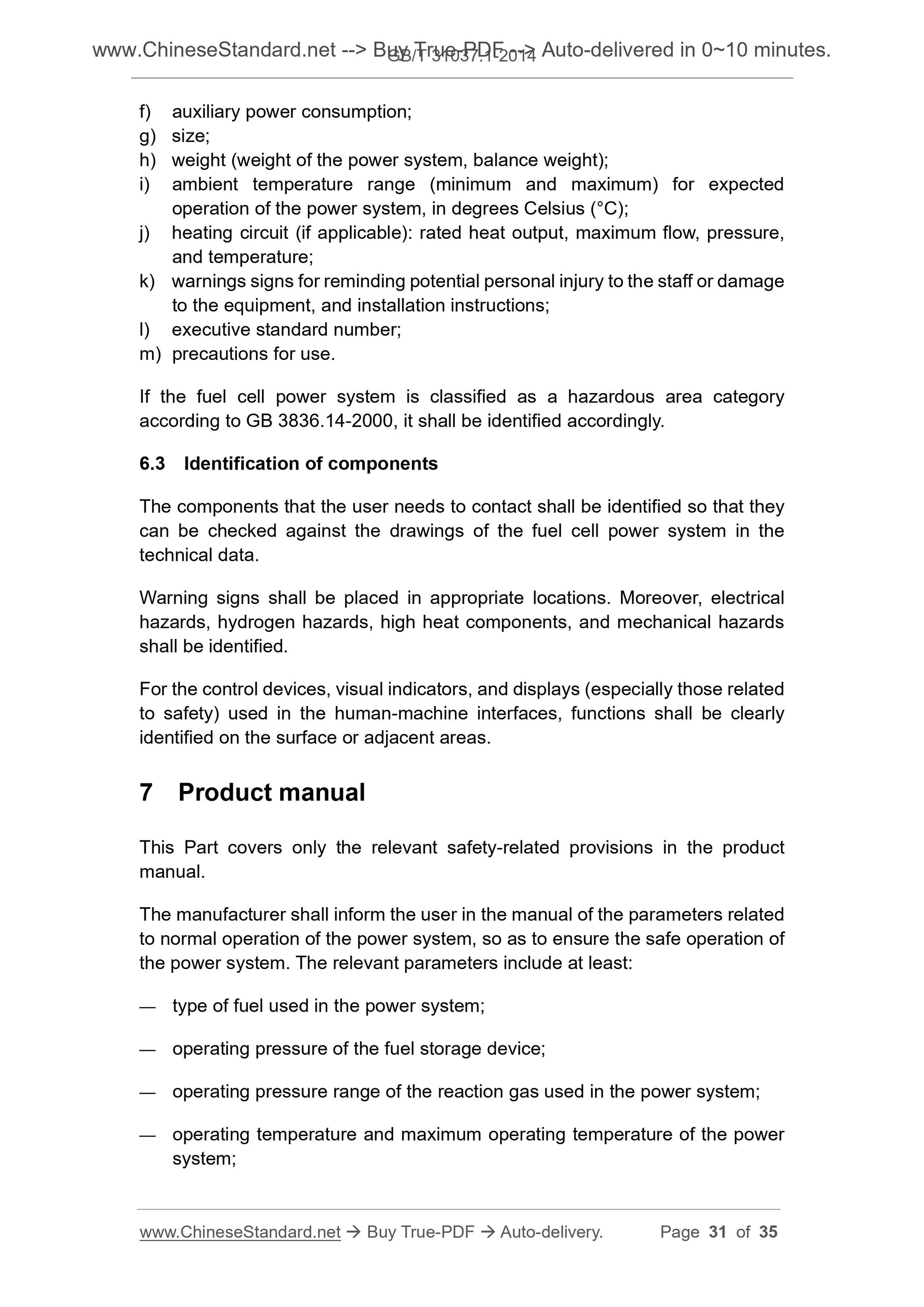1
/
of
12
www.ChineseStandard.us -- Field Test Asia Pte. Ltd.
GB/T 31037.1-2014 English PDF (GB/T31037.1-2014)
GB/T 31037.1-2014 English PDF (GB/T31037.1-2014)
Regular price
$145.00
Regular price
Sale price
$145.00
Unit price
/
per
Shipping calculated at checkout.
Couldn't load pickup availability
GB/T 31037.1-2014: Fuel cell power system used for industrial lift truck applications - Part 1: Safety
Delivery: 9 seconds. Download (and Email) true-PDF + Invoice.Get Quotation: Click GB/T 31037.1-2014 (Self-service in 1-minute)
Newer / historical versions: GB/T 31037.1-2014
Preview True-PDF
Scope
1.1 OverviewThis Part of GB/T 31037 specifies the safety requirements and safety
precautions involved in the construction, identification and performance tests of
the fuel cell power system used for industrial lift truck applications.
Fuel cell power systems that power electric industrial lift trucks for indoor or
outdoor use include fuel cell power systems (referred to as power systems) and
energy storage modules. An energy storage module refers to an electrical
energy storage device that is used to start a power system, or to help or
supplement a fuel cell power system to power internal or external loads. It
consists of a lead-acid battery, a nickel-metal hydride battery, a lithium-ion
battery, a super capacitor, or other energy storage modules with corresponding
functions. This Part covers only the safety requirements of the fuel cell power
system and does not include energy storage modules.
The industrial lift trucks involved in this Part include. counterbalanced fork lift
truck, reach truck, straddle truck, pallet-stacking truck, platform truck, truck with
elevatable operation position, side-loading truck, rough terrain truck, lateral
stacking truck (both sides), lateral and front stacking truck, stacking high-lift
straddle carrier, pallet truck, platform and stillage truck, non-stacking low-lift
straddle carrier, and order picking truck.
This Part is applicable to proton exchange membrane (PEM) fuel cell power
systems that use gaseous hydrogen as the fuel and air as the oxidant.
Hydrogen storage devices suitable for use in this Part include.
— fixed or replaceable;
— refillable or disposable;
— integrated or installed on power systems or industrial lift trucks.
This Part only considers dangerous situations that may cause injury to people,
objects or the environment outside the fuel cell power system, and proposes
safety requirements for such dangerous situations, excluding the safety
used to filter and regulate the pressure of the oxidant (air) input to the power
system, then deliver oxidant (air) to the fuel cell module.
— Thermal management system. It includes, but is not limited to radiators and
associated fans, piping, circulating fluid pumps, valves, sensor devices,
cooling fluid storage and replenishment tanks, etc., which can be used to
keep the power system operating within the manufacturer specified
operating temperature range by heating or cooling or heat removal.
— Humidifying system. A device for humidifying fuel and oxidant (air) to
increase relative humidity.
— Water treatment system. It includes, but is not limited to piping, circulating
water pumps, valves, sensor devices, water storage and replenishment
tanks, etc. When water generated by the power system is used for
humidifying fuel or oxidant or other uses, the particles and metal ions that
are harmful to the power system shall be removed.
— Control system. It consists of sensor devices, circuits, actuators, control
devices, and software programs that are necessary for regulation and
monitoring, so that the power system’s operating parameters are able to be
kept within the manufacturer’s given limits without human intervention, thus
ensuring the normal operation of the power system.
— Power regulating system. It includes, but is not limited to DC / DC or DC /
AC, circuits, etc. The output power of the fuel cell stack will, by regulating
current and voltage according to the requirements for the power required
for the internal device of the power system and the external output power,
provide the power output that meets the requirements of use.
— Ventilation system. A system that achieves air exchange inside and outside
the power system through forced or natural means.
— Fuel cell power system. It consists of all or part of the components in the
schematic diagram for the boundary of the power system, and is combined
with an energy storage module to form a fuel cell dynamic system.
According to its different structures, it can be divided into two types. all-in-
one and integrated.
All-in-one system. All the components of the power system are loaded
into one shell as an integral whole; the display and control interface or
function buttons can be installed in the place where the operator can
conveniently operate according to the actual situation.
Integrated system. All the components of the power system are
dispersedly installed on an industrial lift truck in accordance with the
structural space and the center of gravity of the industrial lift truck.
However, all the components are connected together through circuits
GB 17799.3-2012 Electromagnetic compatibility (EMC) -- Generic standards
-- Emission standard for residential, commercial and light-industrial
environments
GB 17799.4-2012 Electromagnetic compatibility (EMC) -- Generic standards
-- Emission standard for industrial environments
GB/Z 18333.1-2001 Lithium-ion batteries for electric road vehicles
GB/T 18384.3-2001 Electric vehicles -- Safety specification -- Part 3.
Protection of persons against electric hazards
GB/T 20042.1-2005 Proton exchange membrane fuel cell -- Terminology
GB/T 20801 (all parts) Pressure piping code -- Industrial piping
GB/T 20972.1-2007 Petroleum and natural gas industries -- Material for use
in H2S-containing environments in oil and gas production -- Part 1. General
principles for selection of cracking resistant materials
GB/T 24499-2009 Technology glossary for gaseous hydrogen, hydrogen
energy and hydrogen energy system
GB/T 24549-2009 Fuel cell electric vehicles -- Safety requirements
GB/T 28816-2012 Fuel cell -- Terminology
HB 5067 Test method for hydrogen embrittlement evaluation of plating
processes
ISO 15916 Basic considerations for the safety of hydrogen systems
ISO 17268.2-2006 Compressed hydrogen surface vehicle refuelling
connection devices
Basic Data
| Standard ID | GB/T 31037.1-2014 (GB/T31037.1-2014) |
| Description (Translated English) | Fuel cell power system used for industrial lift truck applications - Part 1: Safety |
| Sector / Industry | National Standard (Recommended) |
| Classification of Chinese Standard | K82 |
| Classification of International Standard | 27.070 |
| Word Count Estimation | 23,295 |
| Date of Issue | 12/5/2014 |
| Date of Implementation | 7/1/2015 |
| Quoted Standard | GB 156-2007; GB/T 2894; GB/T 2900.10; GB/T 2900.5; GB/T 2900.90; GB/T 2900.89; GB/T 2900.1; GB/T 2900.12; GB/T 2900.15; GB/T 2900.16; GB/T 2900.18; GB/T 2900.19; GB/T 2900.20; GB/T 2900.22; GB/T 2900.23; GB/T 2900.25; GB/T 2900.26; GB/T 2900.27; GB/T 2900 |
| Regulation (derived from) | Announcement of Newly Approved National Standards 2014 No. 27 |
| Issuing agency(ies) | General Administration of Quality Supervision, Inspection and Quarantine of the People's Republic of China, Standardization Administration of the People's Republic of China |
| Summary | This Standard specifies the terms of industrial lifting construction vehicles, logos and performance test of the fuel cell power generation system security requirements involved and the safety precautions. Provide power for indoor or outdoor use electric |
Share
